
Nymphaeaceae is a family of flowering plants, commonly called water lilies. They live as rhizomatous aquatic herbs in temperate and tropical climates around the world. The family contains five genera with about 70 known species. Water lilies are rooted in soil in bodies of water, with leaves and flowers floating on or rising from the surface. Leaves are round, with a radial notch in Nymphaea and Nuphar, but fully circular in Victoria and Euryale.
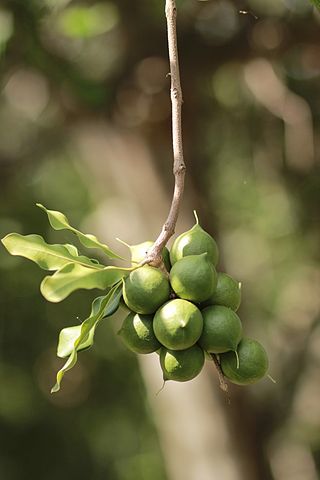
Macadamia is a genus of four species of trees in the flowering plant family Proteaceae. They are indigenous to Australia, native to northeastern New South Wales and central and southeastern Queensland specifically. Two species of the genus are commercially important for their fruit, the macadamia nut. Global production in 2015 was 160,000 tonnes. Other names include Queensland nut, bush nut, maroochi nut, bauple nut and, in the US, they are also known as Hawaii nut. It was an important source of bushfood for the Aboriginal peoples.

Victoria or giant waterlily is a genus of water-lilies, in the plant family Nymphaeaceae, with very large green leaves that lie flat on the water's surface. Victoria boliviana has a leaf that is up to 3 metres (9.8 ft) in width, on a stalk up to 8 metres (26 ft) in length. The genus name was given in honour of Queen Victoria of the United Kingdom. It pushes other water plants aside as it spreads out until only those of its kind remains. When this happens it has nearly completely cut out the sunlight from getting to any plants below the water limited only by circle packing.
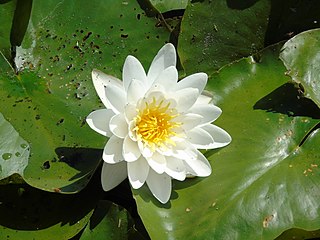
Nymphaea is a genus of hardy and tender aquatic plants in the family Nymphaeaceae. The genus has a cosmopolitan distribution. Many species are cultivated as ornamental plants, and many cultivars have been bred. Some taxa occur as introduced species where they are not native, and some are weeds. Plants of the genus are known commonly as water lilies, or waterlilies in the United Kingdom. The genus name is from the Greek νυμφαία, nymphaia and the Latin nymphaea, which means "water lily" and were inspired by the nymphs of Greek and Latin mythology.
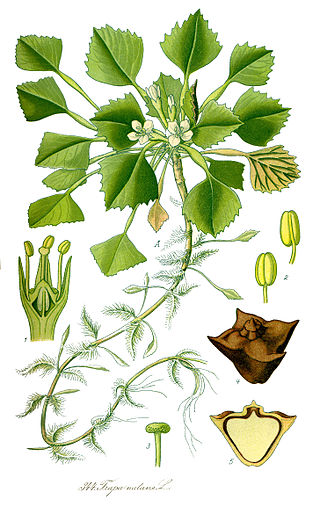
The water caltrop is any of three extant species of the genus Trapa: Trapa natans, Trapa bicornis and the endangered Trapa rossica. It is also known as buffalo nut, bat nut, devil pod, ling nut, mustache nut, singhara nut or water chestnut.

Victoria amazonica is a species of flowering plant, the second largest in the water lily family Nymphaeaceae. It is called Vitória-Régia or Iaupê-Jaçanã in Brazil and Atun Sisac in Inca (Quechua). Its native region is tropical South America, specifically Guyana and the Amazon Basin.
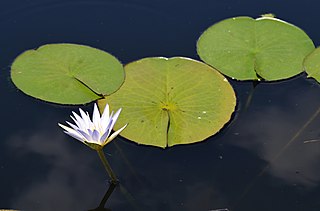
Nymphaea nouchali var. caerulea, is a water lily in the genus Nymphaea, a botanical variety of Nymphaea nouchali.
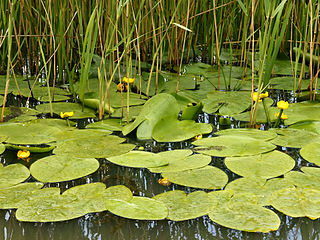
Nuphar lutea, the yellow water-lily, brandy-bottle, or spadderdock, is an aquatic plant of the family Nymphaeaceae, native to northern temperate and some subtropical regions of Europe, northwest Africa, and western Asia. This species was used as a food source and in medicinal practices from prehistoric times with potential research and medical applications going forward.

Carya floridana the scrub hickory, is a small tree native to the Southeast United States, where it is endemic to central Florida.
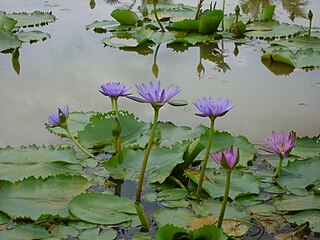
Nymphaea nouchali, often known by its synonym Nymphaea stellata, or by common names blue lotus, star lotus, red water lily, dwarf aquarium lily, blue water lily, blue star water lily or manel flower, is a water lily of genus Nymphaea. It is native to southern and eastern parts of Asia, and is the national flower of Bangladesh and Sri Lanka. In Sanskrit it is called utpala. This species is usually considered to include the blue Egyptian lotus N. nouchali var. caerulea. In the past, taxonomic confusion has occurred, with the name Nymphaea nouchali incorrectly applied to Nymphaea pubescens.

Nymphaea thermarum is a species of water lily that is endemic to Rwanda. Once thought to be extinct in the wild, all wild plants were believed to be lost due to destruction of its native habitat, but it was thought to be saved from extinction when it was grown from seed at the Royal Botanic Gardens, Kew in 2009. A previously-unknown wild population was discovered in 2023.
Bihar lies in the river plains of the basin of the river Ganga. As a result, its land contains fertile alluvial soil and groundwater resources. This makes the agriculture of Bihar rich and diverse. Rice, wheat, and maize are the major cereal crops. Arhar, urad, moong, gram, pea, lentils, and khesaria are some of the pulses cultivated in Bihar. Bihar is the fourth largest producer of vegetables, which is dominated by potato, onion, eggplant, and cauliflower. In fruit cultivation, it is the largest producer of lychee and the third largest producer of pineapple, as well as a major producer of mango, banana, and guava. Sugar cane and jute are two other major cash crops of Bihar.

Euryale is a genus of flowering plants of the family Nymphaeaceae.
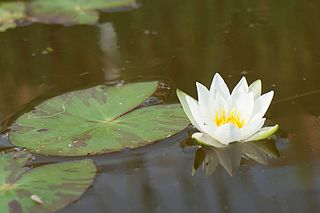
Nymphaea tetragona is an aquatic perennial, species of flowering plant commonly called pygmy waterlily and small white water lily, belonging to the family Nymphaeaceae.

Mithila Makhana is a special variety of aquatic fox nut cultivated in Mithila region of Bihar and Nepal. In Mithila, Makhana is also termed as Makhan. It is one of the three prestigious cultural identities of Mithila: Pond, Fish and Makhan "पग-पग पोखर, माछ, मखान ". It is also famous in Kojagara festival of Maithil Brahmins and Kaysath celebrated for newly married couples. Makhana contains protein and fiber, along with micronutrients like calcium, magnesium, iron, and phosphorus.
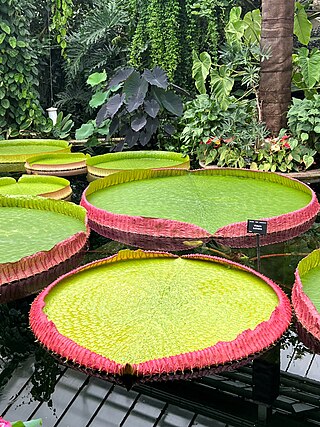
Victoria boliviana, or the Bolivian waterlily is a new species of water lily within the genus Victoria in the family Nymphaeaceae. It is the newest described species of the genus and its largest member in size and was officially identified in 2022. In January 2023, the species was awarded three Guinness World Record titles for world's largest waterlily species, world's largest waterlily leaf and world's largest undivided leaf, with the latter two specifically recognizing a specimen grown in 2012 at La Rinconada Gardens in Santa Cruz, Bolivia.

Nymphaea ampla, the dotleaf waterlily, is a species of flowering plant in the family Nymphaeaceae. It is native to Texas, Florida, Mexico, Central America, the Caribbean, and northern and western South America.

Nymphaea prolifera is a species of waterlily naturally found from Mexico to Brazil and northeastern Argentina. Additionally, it has been reported to occur in Uruguay.

Nymphaea immutabilis is a species of waterlily native to Western Australia, the Northern Territory, and Queensland, Australia.
























